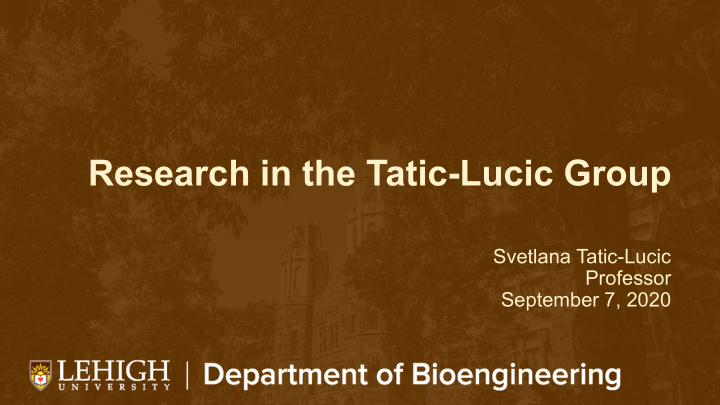



Research in the Tatic-Lucic Group Svetlana Tatic-Lucic Professor September 7, 2020
Svetlana Tatic-Lucic • Professor, Bioengineering &Electrical and Computer Engineering, Lehigh University • Education and Training • Ph.D., Electrical Engineering, California Institute of Technology, Pasadena CA • M.S., Electrical Engineering, California Institute of Technology, Pasadena, CA • B.S., Electrical Engineering, University of Belgrade, Serbia • Research Areas • Applications of MEMS in cell biology and neuroscience, microfabrication, microsensors and microactuators, sensor reliability and packaging • Sample Publications o Zhou, T., Ming, Y., Perry, S.F. and Tatic-Lucic, S. 2016 “Estimation of the Physical Properties of Neurons and Glial Cells Using Dielectrophoresis Crossover Frequency,” Journal of Biological Physics, Volume 42, Issue 4, pp. 571-586 o Zhou, T., Perry, S.F., Ming. S, Petryna, S., Fluck, V. and Tatic-Lucic, S. 2015. “Separation and Assisted Patterning of Hippocampal Neurons from Glial Cells Using Positive Dielectrophoresis”, Biomedical Microdevices, Volume 17, Issue 3, Article number 62
Multielectrode Arrays for Patterned Neuronal Networks • What are the aims? To develop a multi-electrode array (MEA) which will enable stimulation and recording from neuronal networks with pre- defined position of neuronal bodies and neuronal processes • Why is this topic significant? This MEA is a unique platform that enables biologists and medical researchers investigate topics and phenomena for which they did not have appropriate tools before • How is the topic studied? This research requires broad knowledge base in microfabrication, electrical circuits and cell culturing. These MEAs can be used: • In neuroscience for investigating the processes of thought and memory • In sensing applications (to detect neuroactive compounds) • In pharmacological studies • What are the future directions of this research? Developing a highly reliable and repeatable platform suitable for various types of neurons
Micromachined Systems for Mechanical Characterization of Biological Cells ( ) 40 • What is the aims? 20 • To develop a platform for mechanical characterization of Force (nN) individual cells 0 -20 • Why is this topic significant? -40 0 15 30 45 60 75 90 105 120 135 Elapsed time (s) -Clinical diagnosis -Tissue engineering and regenerative medicine 40 35 30 • What are the target Diseases? 25 • Osteoporosis Force (nN) 20 15 10 • What are the future directions of this research? 5 Manufacturing reliable platform that is easy to use and 0 suitable for cells of different types and sizes. -5 0 15 30 45 60 75 90 105 120 135 Elapsed Time (s)
Towards Directional Neuronal Circuits (in collaboration with Yevgeny Berdichevsky) • What are the aims? To develop micromachined PDMS-based platforms which will enable creation of directional neuronal circuits that more closely mimic conditions and functions of in vivo environment • Why is this topic significant? Biologists and medical researchers are lacking good quality tools to understand better the nervous system and understand underpinnings of various mental diseases and disorders • What are the future directions of this research? Developing a highly reliable and repeatable flexible platform suitable for different types and sizes of neuronal populations
Contact • Professor Svetlana Tatic-Lucic Address: 19 Memorial Dr. Office: 610-758-4533 Email: svt2@lehigh.edu Webpage: https://engineering.lehigh.edu/faculty/svetlana-tatic-lucic
Recommend
More recommend